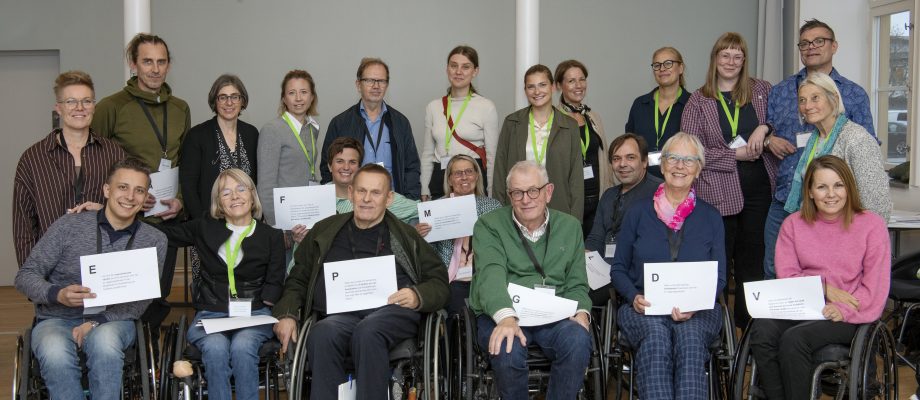RESEARCH FOCUS. How can breathing problems in people living with spinal cord injury (SCI) be prevented? How should their stomach and intestinal problems be treated? And what support do their family members need? These are a few of the priority research questions now identified by the Gothenburg competence centre for spinal cord injury (Ryggmärgsskadecentrum Göteborg) at the University of Gothenburg.
Katharina Stibrant Sunnerhagen, Professor of Rehabilitation Medicine at the University of Gothenburg and Senior Physician at Sahlgrenska University Hospital, is a member of the steering group of the Gothenburg competence centre for spinal cord injury (SCI). She sees the questions identified as both topical and important.

“For us, it’s key that those most affected by the research are also involved in and influence it. I now hope that researchers in Sweden, and maybe worldwide, will use the list to ensure they concentrate on questions that are relevant to people living with or working on spinal cord injury,” Stibrant Sunnerhagen says.
Urgent questions
Identifying the top ten research questions has been a major task for the Center. The list ranks them in order of importance, and the number one priority question concerns the nature of specialized care for people with SCIs.
Priority Setting Partnerships (PSPs), the method used, were developed by the James Lind Alliance (JLA) in the United Kingdom. The method means that people who will themselves be affected by the research, along with their close relatives, personal care assistants, and other care and rehabilitation staff, take part in a multi-step process where ten prioritized research questions are worked out.
The target groups proved to be seeking answers to many research questions. The questions received were sorted into 57 different issues that were then reworked in terms of various priorities and reduced to the ten questions now highlighted as the most urgent to answer. The research questions will also be published in a scientific journal as a guide for future research.
Life change

The questions identified have also come to serve as support for various user organizations whose members live or work with SCI. One group member is Erik Berndtsson, representing the non-profit associations Personskadeförbundet RTP (for people with acquired injuries and their family members) and RG Aktiv Rehabilitering (which runs rehab-oriented courses and physical activities for people with SCI and comparable disabilities).
“There are always new products and medicines, but the questions selected show a continued demand for research and development focusing on the individual’s life change,” says Berndtsson, who is himself living with SCI.
Top ten list for people with SCI
- For people with spinal cord injury, what kinds of specialist care, from the emergency stage to rehabilitation and lifelong follow-up, should be available?
- For people with spinal cord injury, what kinds of support and treatment are effective in preventing, relieving and managing pain?
- For people with spinal cord injury, what kinds of support and treatment are effective in preventing, treating and managing gastrointestinal problems?
- How can the care services lacking specialist expertise in spinal cord injuries best respond to people with these injuries and meet their needs? (For example, local health centres and other primary care facilities, or the care services in other specialist areas.)
- What kinds of help and treatment are effective in helping people to cope with their new life situation, and to find ways of enjoying life, after spinal cord injury?
- For people with spinal cord injury, what kinds of help and treatment are effective in preventing and remedying complications?
- For people with spinal cord injury, what kinds of help and treatment are effective in preventing and remedying breathing problems?
- What kinds of support do close relatives of people with spinal cord injury need?
- The Swedish Act concerning support and service for persons with certain functional impairments (LSS) applies to the under-65s. What are the implications of this restriction for people with spinal cord injury when they turn 65, and for those who get spinal cord injury in old age?*
- What kinds of treatment are effective in improving the healing (regeneration) ability of damaged nerves?
Spinal cord injury
SCI involves damage to any part of the spinal cord or nerves at the end of the spinal canal. It often causes permanent changes in strength, touch, and other bodily functions. Every year, 200–300 people are injured nationwide. Some 50 of them live in West Sweden.
The Gothenburg competence centre for SCI
The Centre belongs to the Institute of Neuroscience and Physiology, University of Gothenburg, in collaboration with Sahlgrenska University Hospital, Region Västra Götaland. Cooperation is also underway with Region Halland, primary care services, municipalities, and interest organizations. The Center was established in 2017, thanks to a generous donation from the Sten A Olsson Foundation (for Encouragement of Research, Culture and Humanities). The Centre works to develop and spread knowledge among people with SCI, researchers, and staff in care and rehabilitation, with a strong emphasis on empowerment.
On its website, the Centre lists the top ten research questions, and a further 14 that are also identified as vital: https://ryggmargsskadecentrum.se/jla/ (in Swedish).
BY: EMELIE AXWALTER & ELIN LINDSTRÖM
*The support granted in accordance with the LSS before retirement age remain for those who turn 65.











